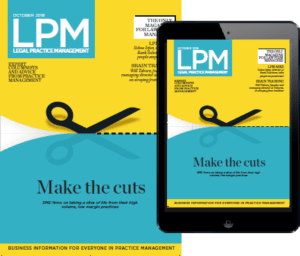
The AI opportunity for the legal industry
Following in the financial sector’s footsteps to leverage AI to enable collaboration in the legal industry, makes for a rational conversation, says Simon Farthing, LexisNexis Enterprise commercial director.
For some time now there have been many examples of AI use cases in our daily life – think Siri, Alexa, facial recognition and more – but generative AI and more specifically, ChatGPT, has seemingly captured the imagination of the world. Perhaps what lends the ‘wow’ factor to ChatGPT is that it’s the most tangible avatar of AI technology thus far.
Its allure is easy to grasp – a few simple commands and it can generate impressive lengths of text, with stealthy realism. “ChatGPT write my daughter’s homework essay on ‘the playground’”; “draft a Fee Agreement for X property”; “draw up my Will based on the following data”; “compose my business report”; and so on. Of course, the level of trust that can, and should be, attributed to its output derived from the worldwide web is a major question mark. Exercising caution over the nature of data that is shared with the chatbot is imperative too. In the workplace, adopting generative AI in consultation with technology providers is the recommended approach.
In business, AI technology more broadly offers tremendous potential to genuinely disrupt traditional approaches, and deliver a positive game-changing customer experience, across industry sectors. In this context, AI’s application in aiding collaboration merits examination.
Frictionless sector-wide collaboration can facilitate cost reduction, better pricing, and business efficiency – all of which are key factors that contribute towards enhancing the customer experience. The financial sector has proven this approach. So, following in the financial sector’s footsteps to leverage AI to enable collaboration in the legal industry makes for a rational conversation.
Take litigation. Potentially there could be an opportunity for the industry to establish standard processes to make collaboration across the sector easier, simpler, and more effective, for the benefit of all involved parties. To this end, what if collectively, the industry players identified the different claim types, the payment types, the typical outcome worth of the claim types, and so forth? With firms predictably generating the same type of data, the involved parties could also agree on the data capture processes, how and where the encapsulated data is stored, and the method or tool by which AI is applied for interrogation and collaboration Thereafter, automated processes could be devised to triage and qualify future claims. It’s not difficult to envisage the speed and efficiency such an approach would deliver, right?
Likewise, the conveyancing sector could explore how AI could be adopted to facilitate creation and enforcement of industry standards and best practice so that there is material and wholesale improvement in customer experience.
These are just a couple of illustrations of how innovative technology, including AI, could be used to the legal sector’s advantage if an informed, collaborative approach is undertaken to define what good practice looks like. In adopting such a mindset, we as an industry can look forward to sustained and continuous improvement of how we use technology in the legal world and as a result, shape how law is delivered in times to come.

Time to build process into the use of collaboration tools like MS Teams
Governance is crucial to making collaboration tools like MS Teams work long term, says Nick Hayne at Quiss. Here’s why firms need to build processes and controls into their information sharing and document management procedures.
Microsoft estimates around 13 million people use Teams every day. So it’s perhaps no coincidence it’s becoming the default platform for workplace collaboration among technology-focused UK law firms, both internally with colleagues and externally with clients.
However, providing a secure hub for collaboration on projects, matters and clients through conferencing, routine communications and information-sharing does not come without risks from a document-management and information-control perspective.
In today’s increasingly fast-paced legal environment, with clients demanding more for less, it’s critical that legal professionals can find the correct version of the documents they need to progress client matters efficiently – wherever they’re working.
Robust security is also crucial to ensuring sensitive materials and related communications can only be shared or accessed by authorised individuals, whether or not they are part of the business.
Keep collaboration on the right track
Teams consolidates multiple applications, making it possible to view, discuss and collaborate effectively on work in one place. This speeds up progress on legal matters and delivers a competitive edge for the firm and their clients.
In addition to the meetings, calls and chat, it brings planning and task management tools into a single hub. And, above all, it connects with the Microsoft Office 365 tools users recognise, from spreadsheets to email, meaning everyone knows how to use it.
It’s easy to understand the appeal of having all these solutions in one place, as it saves time and improves efficiency. Teams makes meetings effective, removing confusion from collaboration and communication to help users make better-informed decisions.
However, this surge in the popularity of Teams is not without its problems. Given the significant effort law firms have expended to comply with data protection demands, now is not the time to allow users to create any Team they see fit and start a free-for-all with sensitive content.
As firms need to keep track of information and the status of every matter, it’s advisable they don’t allow everyone the freedom to use Teams without suitable controls and naming conventions relating to the management of the Teams channel and its lifecycle, all the way through to closure.
Seeking external, specialist support to safely harness the power of Teams will provide the control law firms need to ensure their people are comfortable collaborating through the platform while also respecting necessary boundaries. Only then can firms really unlock the power of collaboration to create a service their clients will really value.

Eight tips for completing your proposal form

Supercharge your business development through client experience
Most Popular

Where are the challenges for SME law firm leadership changing?

The leading annual picture of SME law firms' changing strategic priorities

Law firms undertaking identity verification checks must register as an ASCP
TA Triumph-Adler provides tailored support to meet compliance requirements

Robust onboarding processes are fundamental to effective risk prevention

AI has entered the chat — in a big way




